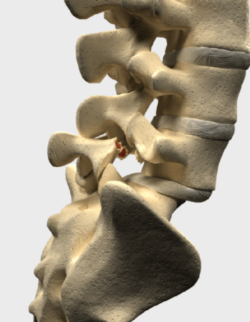What Is Spondylolisthesis?

Lower back pain can be caused by a wide variety of conditions. If you experience lower back pain that lasts for more than a few days, you should visit your doctor. Some causes of pain may disappear by themselves, but others need immediate treatment in order to prevent more serious complications. One common cause of spinal pain in the lumbar area is a condition called spondylolisthesis.
Basics of Spondylolisthesis
This condition occurs when one vertebra slips out of place, misaligning the spine. It typically happens in the lumbar—or lower—spine, although it can occur elsewhere. Spondylolisthesis can cause pain in the lower back and the upper legs. Although this condition can go unnoticed for several years, it should be treated as soon as it is discovered, as it can cause more serious problems if left untreated.
Types of Spondylolisthesis
The two most common types of spondylolisthesis are isthmic and degenerative. Isthmic spondylolisthesis occurs in younger people, while degenerative spondylolisthesis is typically found in the elderly as a result of osteoporosis. There are three other very rare types of spondylolisthesis, as well. These may result from congenital defects, severe trauma, or metabolic bone diseases.
Types of Spondylolisthesis
There are two typical treatment paths for back problems caused by spondylolisthesis. One of these is surgical and the other is non-surgical. Non-surgical treatment is usually attempted first, with surgical spinal fusion only used in more severe cases. In some cases, doctors don’t recommend any treatment if the slip is minor and there is no associated pain. Non-surgical treatment can include pain management with anti-inflammatory medications and rehabilitation. Non-surgical treatment is usually equally as successful as surgery for back pain in the long term, and it poses fewer risks for complications.
If you are experiencing lower back pain or sensitivity near the spine, see a spinal doctor right away to be checked for spondylolisthesis. At the Spine Institute of Nevada, our staff, led by Dr. Perry, uses the latest medical knowledge, technology, and treatments to offer solutions that can permanently relieve your back pain. Schedule an appointment today by calling 702-239-3787.
